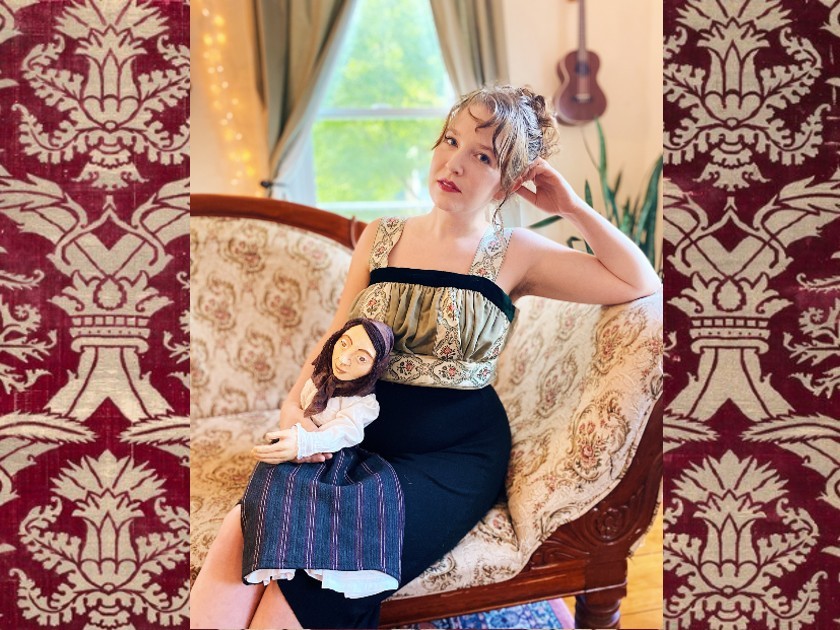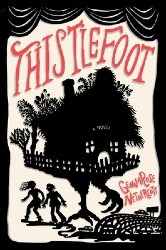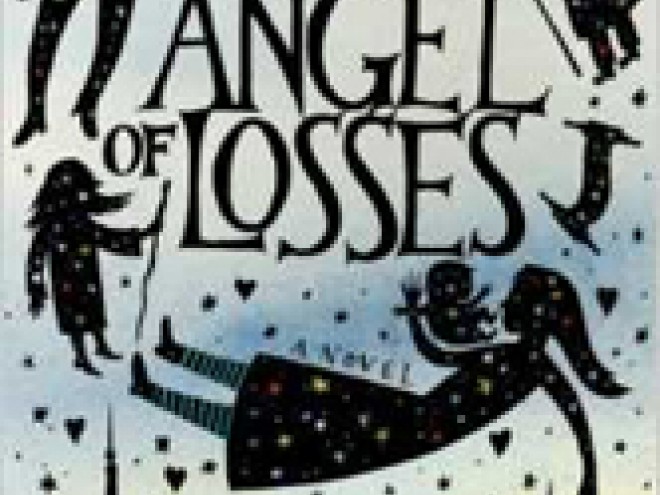
GennaRose Nethercott with Baba Yaga puppet
Background of brocaded velvet panel with Italianate pattern, Cleveland Museum of Art
When I sit down to talk with Shoshana Bass, she’s cradling Baba Yaga’s half-sculpted head in her hands. The eyes are moony, the nose sharp.
“I can’t get the mouth quite right,” Shoshana sighs, sweeping a thumb over the tiny crone’s pursed lips and smearing them away. She rolls a scrap of gray clay between her fingertips, lays it above the chin. “Is it alright if I work while we chat?”
“Of course,” I say.
To be fair, her labor is on my behalf. I’ve hired Shoshana to co-create a puppetry show based on my forthcoming novel, Thistlefoot—a story weaving together Jewish history and the infamous Russian folklore figure Baba Yaga. The woman emerging from the ball of clay in Shoshana’s hands will be my companion on an extensive cross-country book tour.
There’s no one better to translate a character into flesh and blood — or well, fabric and wood — than a Bass. Shoshana, age thirty-five, is a dancer and former trapeze artist. She also happens to be the heiress to a puppet empire — the legendary Sandglass Theater.
Sandglass was founded in Germany in 1982 by Shoshana’s parents, Eric Bass and Ines Zeller Bass. Their first joint piece was about two lovers — a non-Jewish German woman and a Jewish American man — grappling with the histories of their conflicting worlds the night before they embark on a life together. For Eric and Ines, this was far more than fiction. This was their story. The puppet show featured rivers of pale, flowing sand, —which became the inspiration for Sandglass Theater’s name.
Though Ines and Eric’s original show featured Jewish themes, they always felt that it was vital not to limit Sandglass Theater’s subject matter. “It’s important that someone who is Jewish not have to make ‘Jewish’ art,” Shoshana says. “That’s something that my father struggled with when he lived in Germany, at a time when it was not so … welcoming to be Jewish. He’d be asked to direct a Jewish show, and he’d say ‘But … I just want to direct a show.’”
Nonetheless, Shoshana feels that her identity – as a woman, as a ruralite, as an American, and as a German and a Jew – can’t help but leak into her art. To her, puppetry is an ideal medium for integrating different aspects of oneself. “We can take something from within us, embody it in a puppet, and then have a conversation with it. I’m not saying it’s therapy… But it is magical.”
Perhaps it’s also puppetry’s history that lends itself so well to cultural integration. While the earliest known puppets originated in Ancient Greece, they have held significance in cultures from all over the world—likely long before any record. Ivory and clay puppets have been found in Ancient Egyptian tombs; Chinese shadow theater stretches back at least three thousand years; Indonesian shadow puppetry — featuring cut-leather silhouettes playing over a firelit screen — has been around since the tenth century. String and handheld puppets have been popular in Iraq and Iran for over one thousand years. In Italy, France, Britain, and elsewhere in Europe, puppetry served as a vehicle for political and social satire. The list goes on. And of course, as global travel spread, so too did these theatrical techniques and styles.
Like so many others, Jewish culture has a long-standing relationship with puppetry—beginning in Eastern Europe with the sixteenth- and seventeenth-century maggid—or “teller of tales.” A maggid was an itinerant Jewish preacher and storyteller, a sort of rabbinic bard who traveled the land reciting religious tales. While the maggids didn’t use puppetry, their Torah narrations were quickly adopted by groups of actors and Jewish puppeteers. These interpretations often featured life-size puppets and elaborate marionettes. In the mid-seventeenth century, a Jewish puppet company in Prague began performing a version of Purim’s Queen Esther story. This show was such a hit that the puppeteers were invited to London — where it became popular enough to inspire countless new troupes to sprout up all over Europe. Carrying the art form into modern Jewish American communities, Yosl Cutler and Zuni Maud founded a puppet theater called Modicut (a combination of their surnames) on the Lower East Side in 1925. Their shows blended Jewish folklore, left-wing satire, song and dance, and parodies of Jewish culture — all performed in Yiddish.
As an author, I know the limitations of the written word. But with the help of visual language those limits can be overcome. In the moments that words fail, a puppet doesn’t.
It’s into this multicultural, global history that Sandglass Theater was born. Sandglass was based in Germany for four years, before moving to the US in 1986. For its first decade, it was exclusively a touring company. Eric and Ines voyaged from state to state, country to country, with road cases heavy with puppets … and little Shoshana in tow. Then, in 1996, the family purchased a barn in the woodlands of Putney, Vermont, and transformed it into an intimate theater.
Shoshana officially inherited the role of co-artistic director in 2019, receiving the menagerie of puppets with which her father had toured for much of his life — plus the theater itself. Wandering past the box office and toward the dim rows of cushioned seats feels like entering another world. Winged women built from feathers and wool dangle from the ceiling. A knee-high clown squats on a pedestal — his belly swinging open to reveal a secret hollow inside. Suspended above the ticket counter, a gaggle of puppets make an escape in a lace-covered hot air balloon. Even without puppeteers animating them, the puppets feel alive.
“We say animating, rather than manipulating,” Shoshana explains. “Puppetry has such a misunderstood connotation of control — but in its most beautiful form, it’s not that at all. As a puppeteer, you’re with a puppet, standing behind it, supporting it. The work of the puppeteer is to get out of the way, so the puppet can really live. There’s a lot to play with in terms of power dynamics with puppets, so if you want to talk about power or oppression, it’s a great tool.” And Sandglass Theater does not shy away from wielding that tool. From D‑Generation (a show that gives voice to elders with dementia) to Babylon (addressing the worldwide refugee crisis) to Shoshana’s current work-in-progress, Feral (exploring womanhood and intuitive knowledge within patriarchal systems), many of its productions use puppetry to encourage social justice. And stitched into all the work: a raucous sense of playfulness. Whimsy and delight become tools for change.
In 2016, Shoshana began performing a show called When I Put On Your Glove, which tells the story of a young woman taking her place as the new generation in a family of puppeteers. The show features her father’s puppets, the ones he was touring with back when he first met Ines — allowing these puppets to reawaken. There’s a miniature Yiddish shoemaker at his workbench. A monk impatiently striking a golden gong. An acrobat climbing an impossibly tall ladder. Oh, and sand. Ribbons and ribbons of sand, falling from the ceiling of the theater – the very same sand Eric and Ines used in their original show.
“It’s important to us that there’s a language that goes beyond words,” Shoshana says. “The puppet — it helps us reach into places we cannot understand. But we can reach. And we can strive to be more empathetic — always. These are grand ideas, but also very simple ideas. The puppet’s power is in its simplicity.”
This is precisely why I gravitated toward puppetry in the first place. As an author, I know the limitations of the written word. But with the help of visual language — with metaphor housed in an animated body — those limits can be overcome. In the moments that words fail, a puppet doesn’t.
The sun has begun to set outside the walls of Sandglass Theater’s workshop, and Baba Yaga’s mouth still isn’t quite right. The lips are too tight, too thin. But Shoshana will keep working, keep playing, keep creating — until the language that goes beyond words is found.
GennaRose Nethercott is a writer and folklorist. Her first book, The Lumberjack’s Dove, was selected by Louise Glück as a winner of the National Poetry Series, and she is the author behind the narrative song collection Modern Ballads and Lianna Fled the Cranberry Bog: A Story in Cootie Catchers, among other projects. She tours nationally and internationally performing strange tales (sometimes with puppets in tow) and composing poems-to-order for strangers on an antique typewriter with her team The Traveling Poetry Emporium. She lives in the woodlands of Vermont, beside an old cemetery. This is her debut novel.



